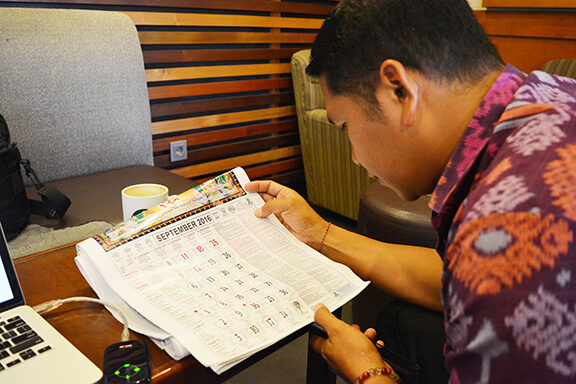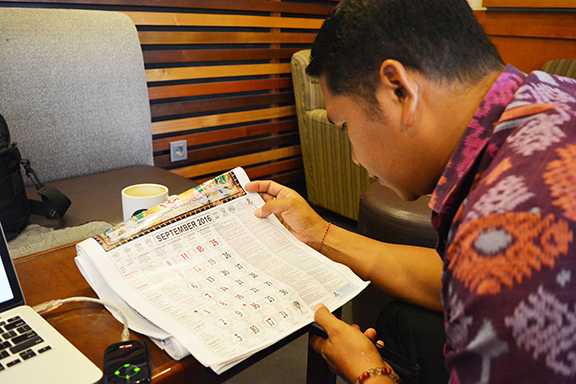Update #3
Dear friends,
As you may have heard, Jakarta experienced an attack on Thursday. We have been following the developments closely, on the local news, international news, and through our contacts on the ground (intelligence contacts, along with family and friends). Jakarta unfortunately has consistently been experiencing turmoil for many decades, and this seems to continue.
Although these attacks have taken place in Indonesia, Bali is a long way from Jakarta – by land as well as culturally. Due to this, protests and revolutions that occur in Jakarta rarely spread to Bali. Although there have been attacks in Bali before, the people, culture and religion of Bali are not inclined to support such extremism.
In an effort to answer some potential questions, we would like to remind you that our itinerary includes mostly locations that are far removed from tourist areas where such attacks, if any, would likely take place in Bali. We will be situated in intimate hotels and villages that are closely knit with their communities, where Balinese Hinduism is central to life. Very little occurs in these villages without the community knowing of it. The villagers are very conscious and inquisitive of who comes and goes.
Regardless, our priority is still, first and foremost, the health and safety of our participants. We are and will continue to keep a close watch on the developments. At any point, if we find that it is unsafe for travel in, around, or out of Bali, we will cancel the trip without hesitation.
Here is our January update on the trip:
Greetings and blessings in the New Year 2016!
Another month has passed, and we are closer to our exploration of Bali together. With the ending of 2015 another milestone in trip planning arrives: the release of the 2016 Balinese calendar. The Balinese calendar is a tremendously complex document combining 3 unsynchronized calendars. The Gregorian calendar, Balinese Pawukon calendar and the Balinese Saka calendar.
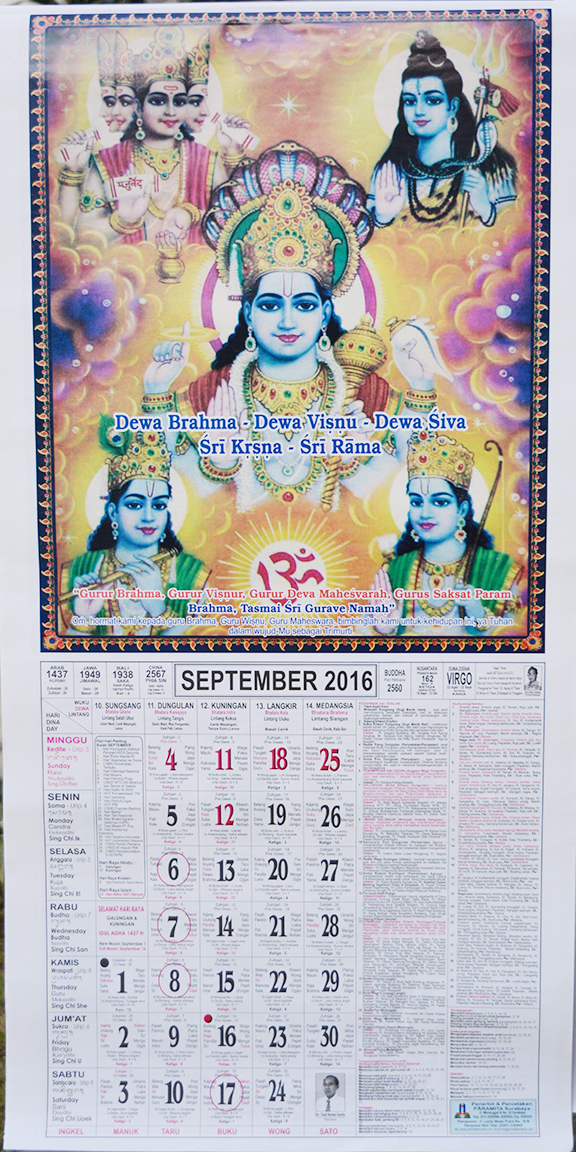 The Pawukon Calendar.
The Pawukon Calendar.
The Pawukon year consists of 6 months made up of 35 days each, adding up to a total of 210 days. This total number of days is believed to be rooted in the cycles of the thousands of years old rice growing tradition in Bali. The tricky part of the Pawukon calendar comes in understanding the weeks and the weekdays. The calendar has 10 different week-cycles, all running simultaneously. The weeks are from one to ten days long all with their unique set of names for the week days. That means the same day often has different names, depending on which of the 10 week cycles is being used. To add to the complexity, the ordering of the weekdays is not always the same (like in the Gregorian calendar, where Wednesday always follow Tuesday) and a 4, 8 or 9 week is not always 4, 8 or 9 days long. This also means that since 210 (the days in a year) cannot be divided by these numbers, some weeks have extra days added. If you are interested in the exact details you can read a very detailed explanation here.
The Balinese Saka Calendar.
The Saka calendar is based on the moon cycles and the year is divided into 12 months consisting of 29-30 days each with each month beginning after the new moon. Every 30 months an extra month is added to keep the calendar in sync with the solar year. The Saka calendar is the calendar that determines the date for the Balinese New Year, Nyepi, the Day of Silence where the entire island shuts down leaving room for self-reflection and meditation (including Airports, ATM machines, and supermarkets).
Other Influences.
The combination of all these calendars in the Balinese calendar also takes into account astrological alignments, the rise and fall of the presences of different gods and demons, and yin and yang energies. Every day has meaning. The calendar governs the days which are chosen for ceremonies, weddings , celebrations, cleansing, business operations, and many other facets of life for the Balinese.
We have been waiting for the release of the hard copy of the 2016 (Saka 1938) Balinese calendar to best plan our visits to temples and healers so that they are in line with the optimal days. Nyoman Wisantono, our wonderful Balinese counterpart (see photos), and I have analyzed the Balinese calendar to define the best dates for activities.
 An Introduction to Nyoman.
An Introduction to Nyoman.
He was the person who took me on my first visit to see Ida Maharesi, the high priestess of Bali Hindu Dharma (more about her will be shared later). He is certainly a man who knows the ways of the culture and radiates it through his being. For example, Nyoman works with Ida Maharesi during her cleansing and blessings on those before her. Nyoman is soft spoken and has a very eloquent way of explaining Balinese culture. He considers himself a person of the light. His sons, both Balinese dancers, are famous for their expertise and skills in dancing.
Knowing the intricacies of the Hindu-Balinese ways, Nyoman expressed great happiness when we looked at the specifics dates in alignment with the Balinese calendar. He confirmed that it is a very good time to be planning such a trip to Bali and shared that he feels very happy with our plan to visit both Mengangan and Nusa Penida, as he has experienced healing at both of those sites. He will be joining us for the entire trip.
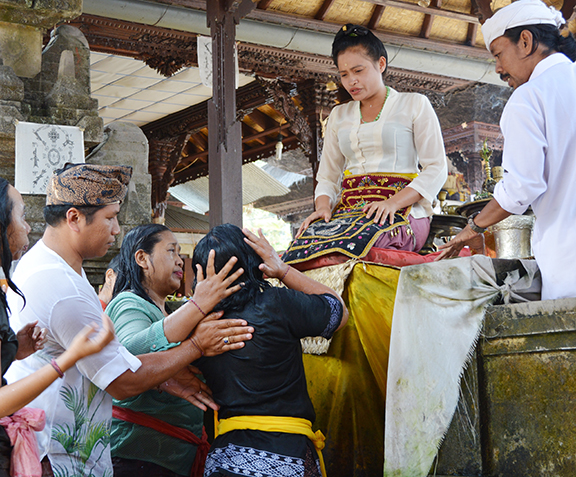
Our Travels and the Calendars.
To best align ourselves with the optimal energies for a healing day, we have planned our date to visit Ida Maharesi on September 24th 2016. Our plan to visit the Quan Yin temple on the small island of Menjangan also perfectly aligns with the full moon and Kuningan day on September 27th, which is a very high holiday for the Balinese. Kuningan day marks the end of the Galungan festival that revolves around the victory of dharma over adharma – good winning over evil, or the higher self over the ego. To Balinese, dharma represents living in the good and virtuous way whereas adharma is the distractions and vices that lead us astray from that path.
The series of Hindu religious ceremonies that are performed during the 10-day Galungan-Kunnigan period are generally considered to be the most important ones of Hindu Bali. During this period, the followers of the Balinese Hindu Dharma religion focus on the importance of living a life based on dharma. It is a holiday period when people generally return to their village and pay respect to their families and also ancestors through offerings (cenang), ceremonies (upacara) and performances of traditional dances especially the Barong dance. It is believed to be a time when good spirits come to visit, to celebrate and be entertained, and it is a very happy and celebratory time of year across Bali.
Our trip commences during the Galungan festivities. The main Galungan day takes place a couple days before we start our trip, but the island will still be looking its very best! Beautiful decorations known as Penjors are lining virtually every street in Bali, creating a beautiful vista.
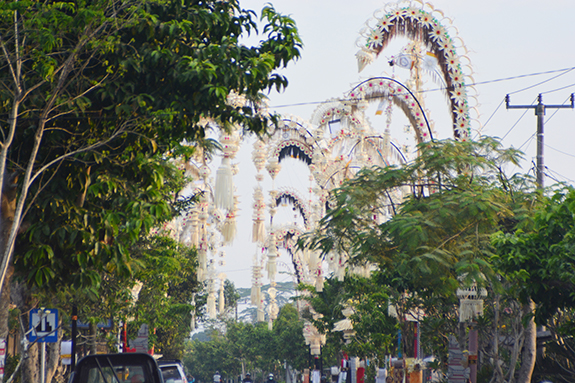
Penjors (see photo above) are large bent pieces of bamboo traditionally decorated with yellow coconut leaves, pala bungkah (roots – sweet potato or cassava), pala gantung (fruit – cucumbers, oranges, bananas), pala wija (cereal – rice, corn), plawa (leaves), traditional cakes, 11 Chinese coins, and a small shrine with some offerings.
Almost every home and business creates one of these beautiful decorations. It is quite a sight. During this festival time, we should have the opportunity to see several authentic Barong and other dances in the remote villages in and on our way to Tejakula and Gaia Oasis in North Bali.
The alignment of the dates of our journey with the Balinese calendar is great. Experiencing Bali during one of the high holidays is extra special. We are also very lucky to have meetings with several of the islands luminaries, especially on these dates.
The trip continues to unfold with an auspicious air. We look forward to seeing you all here in September! Stay tuned for more posts. We will do our best at answering any questions you have.
Your Attire for Occasions.
On another note, for the occasions that call for the wearing of the Kebaya (traditional dress consisting of sarong , sash, shirt with addition of headdress for men) used for ceremony and when entering temples, Nyoman suggested participants may be more comfortable wearing their own shirt or blouse. We will let you know what colours to bring for these occasions. Men are required to wear the Udeng (head dress) in addition to the sarong and sash which we will supply. Women are expected to wear the sarong and sash which we will supply, and their hair is expected to be neat, and if it is long, tied up. (Please note: menstruating women are forbidden to enter any temples in Bali.) If you wish to have a complete Kebaya: sarong, sash and shirt we will order that for you.
Best wishes from Bali,
Alex and Kartika

